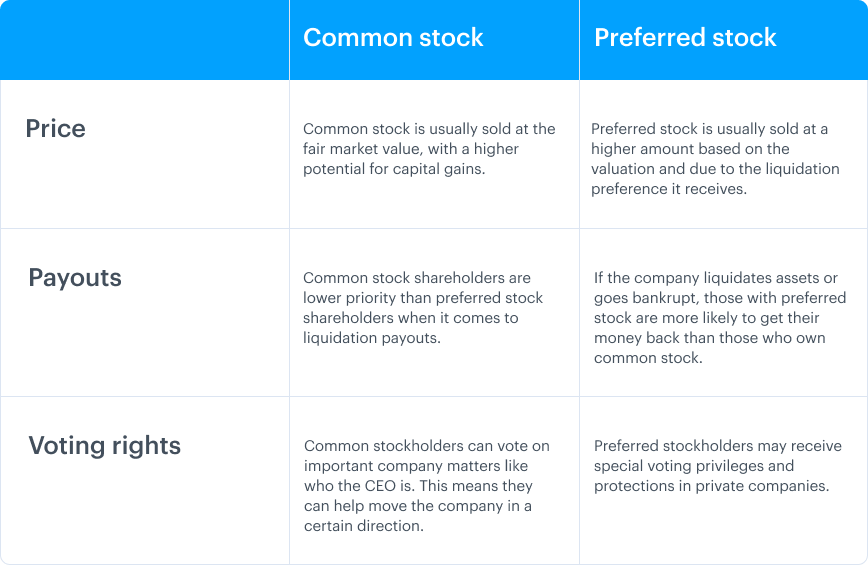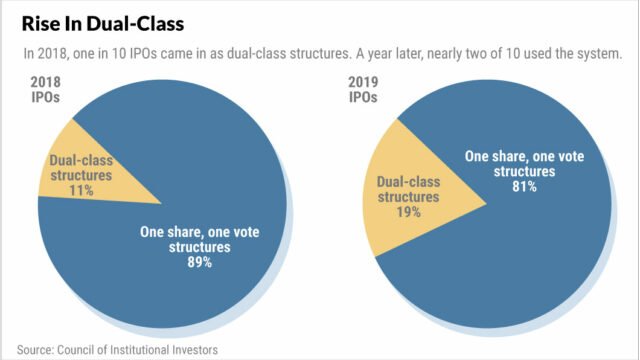How Startup Equity Ownership Works: Understanding Common vs Preferred stock shares as a Founder
There are plenty of perks when it comes to founding or working at a start-up, being your own boss, creating your future, building something innovative or disruptive to the status quo, etc. But for founders and early employees who help build it owning a piece of a potentially multi-million (or billion) dollar start-up is undoubtedly one of the best.
In short, having equity in a company means that you have a stake in the business you’re helping to build and grow. You’re also incentivized to grow the company’s value in the same way founders and investors are. Ownership in a stock corporation (private or public) is represented through shares of stock. Shareholders are the people who own the shares and are thus part of the corporation.
A company called Capbase also wrote an article about this topic, and they explain that even though holders of company stock may have an ownership stake in the corporation, the shareholders do not control the corporation directly, even though shareholder approval may be required for certain decisions made by the corporation’s directors. Shareholders, instead of exercising direct control over the corporation, have control over who is on the board of directors. In turn, the board of directors controls the corporation through the corporation’s officers.
And as a founder or early employee receiving equity is no simple matter—equity packages come in all shapes (stock options, restricted stock units ) and sizes. To reiterate this point an article by Carta explains “stocks are units of ownership or equity in a company or firm. Private companies issue common stock or preferred stock. Both types offer different benefits to shareholders. In general, common stock is reserved for employees, while preferred stock is given to investors.
Key Takeaways
- Your VCs will get preferred stock; unlike your common stock, it will come with special privileges
- Liquidation preferences reduce investor risk; understand what they’ll mean in different scenarios
- Don’t come to the negotiating table without consulting with an experienced advisor first
An interesting article published by Lewis Hower in Silicon Valley Bank, states that “in the world of startups, not all shares are created equal. The VCs who finance unproven companies will insist on contractual agreements that mitigate the risks they take with their money.” He further explains that “those contracts are expressed in the terms of underlying preferred stock. As you negotiate those terms, it’s important to understand what they mean — and to make sure you don’t give away the store before your startup gets going.” Lewis said.
What is common stock?
Common stock in a private company is generally directly issued to founders and early employees. After reaching a certain amount of employees, private companies often issue common stock option grants, which give, an employee a right to exercise (buy) those shares at a set price. If an employee exercises an option, the company will issue the corresponding number of shares of common stock to the employee.
Here is the thing, typically common stock may perform well in the long run if the value appreciates but it also poses a risk to stockholders because dividend income isn’t guaranteed in the case of most venture-backed corporations. Common stockholders also come last in liquidation preference. This means whenever a company is acquired, common stockholders receive liquidity only after preferred shareholders are paid.
What is preferred stock?
Preferred stock shares are primarily issued to investors (venture capitalists, angel investors, PE firms) when they finance funding rounds. This is a different ‘class’ of shares to common shares. It is considered less risky than common stock since preferred stockholders get priority on company assets over common stockholders. This gives preferred shareholders primary access to company assets in a liquidity or bankruptcy event. It is worth understanding that in every new round of investment there will most likely be a new ‘class’ of preferred or preference share which will be issued.
According to Money Crashers, preferred stock first began to be officially used by the railroads back in the 1800s. It has since become popular and the preferred class of shares for legendary billionaire investors like Warren Buffett. A Forbes contributor Alejandro Cremades noted that Buffett’s Berkshire Hathaway also boasts one of the most notable differences in classes of stocks in terms of trading price. You can buy Class A shares for several hundred thousand dollars per share. Or Class B shares for a couple hundred dollars. More recently, the boom in angel investing and venture capital has made preferred stock much more prominent. It is expected by most investors when it comes to participating in startup funding rounds.
Common Share Stock vs Preferred Share Stock Classes
 (image credit: Carta)
(image credit: Carta)
When reading about venture-backed startups, you may frequently hear the terms “preferred shares” or “series A” or “series preferred shares”. What do these terms mean and how do they relate to board control in a startup corporation? Why do startups typically issue multiple classes of shares?
Startups commonly issue both common and preferred stock. Preferred stock differs from common stock in that preferred stock has additional rights and privileges that common stock does not, particularly with regard to liquidation and dividend preferences, at a minimum. Startup common stock will be issued to founders, employees and consultants, whereas preferred stock is typically only issued to investors.
When a startup incorporates (C-corp), the corporation typically authorizes a certain number of common shares in the articles of incorporation that are filed with state officials to register the new corporate entity. Then, when a startup raises a large round of capital, an amended charter will be filed with state officials to authorize a new class of preferred stock that will be reserved for the investors participating in that financing round.
As I mentioned earlier is that with each subsequent financing round, the startup will typically authorize a new series of shares, for issuance from the preferred share pool. Financing is usually referred to by the series of stock that was created in that round of financing for the startup. This is where the terms “Series A” and “Series B” come from — the Series A preferred shares are the first preferred shares issued to investors in the startup, and the Series B the second, the Series C the third, and so on. While it is not common for common stock to be divided into series, preferred stock is almost always divided into one or more series with each financing round.
Why do Venture Capitalists want preference shares?
Alexander Jarvis explains what might seem fairly obvious but In short. your startup has three outcomes:
- Do super well (Rare)
- Do ok, or (A few)
- Die (most)
Die – because most startups fail, and investors know this. No one is getting something.
Do OK – some companies raise a lot of money and get a meager outcome. There is something and investors want it all.
Perform super well – when you kill it, this liquidation stuff doesn’t matter that much as it’s bottles and models for everyone. Investors don’t take their preference, they convert to common and take their fair share (unless they have participating preferred and they get both their investment and their unfair share).
It’s the middling outcomes that investors are optimizing the downside for, the OK ones. They want to make sure they get their money back whenever they can. In the SVB article, Mr. Hower explained that it is in this middle outcome where unfortunately the story is all too common for the employees working at a startup in Silicon Valley. A high-profile startup sells for tens of millions or better. It’s not the home run many were hoping for, but it appears to be a solid single or double. And yet, after the dust settles, employees, and sometimes founders, find that their equity stakes in the company are essentially worthless. Investors, on the other hand, fare better, sometimes recouping their money or even pocketing a positive return. One example that comes to mind is the failure of the coworking startup WeWork, in 2019 the company tried to go public but it ended botching it, and even though the founder Adam Neuman got a huge payout from Softbank to purchase his shares and take control of the company. An article by Wealthspire wrote that as a result of Softbank’s bailout and far lower valuation, an estimated ~80-90% of stock options held by employees became worthless!
Like many high-flying startups, WeWork used the promise of equity and the specter of a big payout as a recruitment and retention tool. There are plenty of other startup examples besides this.
Tim Tuttle, founder and former CEO of MindMeld, a maker of conversational apps backed by artificial intelligence that was acquired by Cisco in 2017. Told SVB that “the people that give you money get paid back first.” The same dynamic, where investors take precedence over employees and founders, comes into play when a company is shuttered.
VCs demand liquidation preferences to mitigate their risk
Founders don’t get preferred stock. But it’s nearly impossible to raise venture capital without issuing preferred stock, or preferred shares. In most cases, VCs today won’t hand over a dime in exchange for common shares, the form of equity extended to founders and employees.
Preferred stock, unlike common stock, is exactly what the name implies. Its owners receive preferential treatment over other investors in specific situations. What exactly that means is negotiable, and it will end up in the fine print of your term sheet. It can involve a wide range of special rights. The most common and important is the liquidation preference.
If your company is a runaway hit, you’ll likely never have to worry about liquidation preferences. But if your startup goes out of business or ends up selling for less than what it was once valued, liquidation preferences will come into play. The liquidation preferences mitigate the risk investors face by ensuring they get paid first. The fine print will determine how much, if any, remains for you and your employees.
Fortunately for startup founders deal terms have become increasingly standardized
A Silicon Valley law firm partner Ivan Gaviria, at Gunderson Dettmer, told the SVB contributor “the leverage is with the entrepreneur, there’s a ton of capital available and a lot of competition for deals.” Given those conditions, Gaviria says most venture capitalists will ask for and receive a liquidation preference called “1x, non participating.” Since liquidation preferences are expressed as a multiple of the initial investment, the 1x means they will receive a dollar back for every dollar invested, a full recouping of their money — as long as there’s enough to cover this. Common shareholders will divvy up what’s left. The term “non participating” means that the investor has a choice. He or she can receive their original investment back or convert their preferred stock into common stock and share in the proceeds according to their equity ownership, whichever amount is greater.
While terms are becoming standardized, sometimes entrepreneurs get into trouble because they are fixated on maximizing their company’s valuation in a given round. “I have seen companies raise money and negotiate for higher valuations and, in trade, they give up more favorable liquidation preferences,” says David Van Horne, a partner at the law firm of Goodwin Procter. “More often than not, that ends up being a bad trade.”
The use of dual class-shares has been growing recently

So tech company founders and CEOs, such as Alphabet, Alibaba, Facebook or Shopify, went public they issued dual-class shares that essentially granted its founders and insiders super-voting rights to control boardroom decisions even as economic interest in the firm is dispersed more widely. An article in the Harvard Business Review, points out that some older, family-controlled firms, such as Ford Motor Co. and The New York Times Co also have this dual-class shares voting rights. This gives founders a lot of control over their companies even decades later. Just look at an example of the power that Mark Zuckerberg has.
If you don’t hit your milestones things can get trickier in later financing rounds
The SVB article mentions that things can become more complex and dangerous in the later financing rounds — especially if your company has struggled to hit milestones. In these situations, investors might ask for 2x or 3x liquidation preferences, meaning they would receive twice or three times their original investment before common shareholders are paid. That all but guarantees that employees and founders won’t ever see much for their equity, unless they manage to turn the ship around.
Another thing to understand and be aware of is that investors might also ask for anti-dilution provisions. These are clauses designed to protect an investor’s ownership percentage from being diluted in future funding rounds where the company issues new stock for a lower price. If an investor has negotiated an anti-dilution clause, their stake in the company is maintained through formulas that turn each preferred share into more than one common share. Exactly how much more depends on the situation and the method specified in the anti-dilution agreement.
Be mindful of investor ‘double dipping’
If a company lacks leverage, investors sensing big risks might even try to negotiate for “participating preferred shares,” also known as the “double dip.” said the Silicon valley law firm partner Ivan Gaviria stated “preferred participating is the thing you want to be wary of.”
What does that mean? During a liquidation event, an investor with participating preferred rights is first in line to recoup their initial investment. If any proceeds remain after that, the participating preferred investor would then pocket an additional share proportional to their percentage ownership stake in the company on a pro rata basis with common shareholders. (Pro rata is a Latin term that means whatever is allocated will be distributed equally.) Hence, the double dip — preference and participation.
Mr. Gariria gives an example, “If a company sells for $100 million,” says Gaviria, “an investor with participating preferred shares might take their original $20 million investment off the top and then take 20% (their percentage share of the company) of the remaining $80 million such that common gets 80 cents on the dollar on the amount remaining after the preference.” In later rounds, common shareholders could end up with as little as 30 or 40 cents on the dollar.
An example of preferred stock with and without liquidation
Say an early-stage startup raises $500,000 in its seed round at a post-money valuation of $2.5 million, giving investors a 20% stake. The chart below shows how much money investors receive if the company is sold for between $2 million and $6 million.
With non-participating preferred stock, investors get to choose the greater of
- a) exercising their liquidation preferences; or
- b) converting their preferred stock to common stock and receiving a sum proportionate to their equity stake.
In the worst-case scenario for founders and employees ($2M exit with 2.0x liquidation), common stockholders with 80% ownership will receive $1 million — the same amount as preferred shareholders with 20% stake.
| Exit Value | Return based on ownership stake | Return based on 1x liquidation | Return based on 1.5x liquidation | Return based on 2x liquidation |
| $6 million | $1.2 million | $500,000 | $750,000 | $1 million |
| $4 million | $800,000 | $500,000 | $750,000 | $1 million |
| $2 million | $400,000 | $500,000 | $750,000 | $1 million |
Keep in mind the terms of preferred shares are negotiated between founders and investors
David Pakman, who founded one of the first cloud-music companies and is now a partner at venture capital firm Venrock. Stated that founders who agree to give up 3x preferred participating rights are typically desperate for money. In a bull market, such terms are very rare. He went on to explain “if investor X asks for a bunch of things that are completely out of market that no other investors are asking for,” Pakman said, “then he or she is unlikely to get them unless the entrepreneur is having a super hard time raising funding.”
Cash-strapped startup founders must make these decisions very carefully, as they could have dire consequences later, says MindMeld’s Tuttle. Consider the following scenario, Tuttle says: You do a financing round in desperation where you agree to a high liquidation preference and shortly after, you get a modest acquisition offer. While the deal would have been life-changing for founders and employees, due to the high liquidation preference, they don’t see any upside. “In that moment it’s very frustrating for founders,” Tuttle says. “But the reason they’re there is because they weren’t able to convince investors to give them the money they needed to get there without introducing these aggressive terms to offset the risk.”
Conclusion
There are two important things you can do as a founder to mitigate the possible downside of preferred stock. The first is to hire a startup good advisor — someone with experience who knows the investor landscape and the players.
The second is to execute on your startup’s plans, hit the key milestones and benchmarks and build a great product. If you do that, everything else falls in place. One mistake some startup entrepreneurs make is being too focused on deal terms and valuations. You should be focusing on building a great business. Mr Gavira gives a final piece of advice, saying “I tell them, ‘Hey, let’s focus on getting the investors to fall in love with your company, your team, you.’” he says. Like with any negotiation, he adds, “most of this stuff is a leverage game.” Too often companies focus on presenting the product, neglecting relevant metrics, business model economics, and a thorough go-to-market strategy. Benchmarking performance against the competition to identify cost savings and revenue opportunities can be helpful. Preparing due diligence materials to check for consistency in financials, projections, and statistics is also helpful when fundraising. Huckabee CPA provides small businesses and startups with flexible outsourced accounting, CFO consulting and financial services. Have questions, reach out to us for a free consultation.











